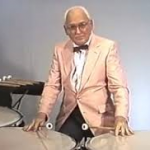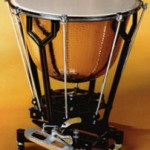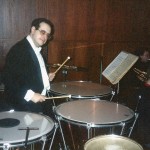Timpani|Light timpani
My first encounters with Light timpani came in my first lessons with Mr. Hinger during my sophomore year at Manhattan School of Music. As I mentioned in one of my earlier posts, Dan had his teaching studio at his home in Leonia, New Jersey. His students were required to take the subway and bus in order to reach his studio, which was fully equipped with a set of four timpani (two cable-tuned and two pedal-tuned) as well as a marimba and snare drum. The two pedal-tuned instruments were manufactured by the American Drum Mfg. Co. of Denver, CO. At this time, it was managed by its founder, Walter Light, who was also the timpanist of the Denver Symphony Orchestra. The drums corresponded in design to what we now know as the Mark XIs, with the master tuning handle across the drum from the player’s side. According to Dan, these drums were, while similar to those he last used in Philadelphia, although the set in the studio was owned by his son Bill, and Dan was now using them to teach on. I remember them being easy to use and sounding very clear and pure in tone, but other than lessons, that was about the extent of my use of these particular instruments during my time at MSM. They were soon replaced with Dan’s own Touch-Tone pedal timpani.
My next experience with Light timpani came during my time as timpanist with the Albany Symphony Orchestra. I did not use them with the ASO, but was exposed to them during the several visits I made to Cleveland to take lessons with Cloyd Duff, another renowned timpanist who became a good friend and mentor.
His studio at the Cleveland Institute of Music on the campus of Case Western Reserve University was filled with timpani. Among the many instruments were two sets of Light Mark XIs. He was a player taught to use the German style of timpani placement by his teacher, the redoubtable Oscar Schwar, the long-time timpanist of the Philadelphia Orchestra, with the larger drum to the right, and the rest of the drums arranged as in a drum set, with the smallest drum on the left. My being taught the American placement, which corresponds with the piano keyboard, didn’t let that stop Cloyd from having me use the good drums (although there was a set of Ludwigs available for those who insisted on American placement). He just turned them around – and we managed the lessons well enough, as they were devoted to his concept of sound.
I remember how clear the drums sounded – the pitch was bell-like. This was due to two factors – his method of “clearing” the heads as well as his technique, and the drums themselves. I had never heard drums ring so clear before. I was quite impressed.
A False Start
I had studied on and off with Cloyd during the period 1978 and 1980 and went to Cleveland about three or four times. Each time, I came away with an appreciation of the instruments and a desire to get my hand on a set of these whenever the opportunity presented itself. I thought an opportunity had presented itself during the spring of 1982, when I was occupying a consortium position of timpanist of the Evansville Philharmonic and Owensboro Symphony Orchestras and adjunct instructor of percussion at the University of Evansville. My wife and I decided that we could afford purchasing a pair of Mark XI timpani – sized 26 inch and 29 inch, and I actually made contact with Marshall Light, who had since replaced his father as head of the firm (Walter Light unfortunately passed away in 1979 at the early age of 52) and placed an order for the instruments. However, several weeks later, our finances took a turn for the worse, and I had to withdraw the order, much to my intense disappointment.
The Metropolitan Bs
In 1983, I was appointed solo timpanist of the Oslo Philharmonic Orchestra, a position I held for nearly sixteen years. The orchestra was equipped with a complete set of Hinger timpani (including a piccolo timpano), and a set of Ludwig Professional Symphonic timpani. I loved the Hingers, but was less than enthusiastic with the Ludwigs. I began
I was excited, and together with my assistant timpanist, Trygve Wefring, we unpacked the drums and got them cleaned up from the packing material and I then cleared the heads, and we set them up on stage after a rehearsal and compared them to the Hingers, which were set up for the week’s rehearsals and concerts.
We were both impressed by the clarity of the pitch and the sound quality, but we noted the fact that this model featured a lighter aircraft aluminum frame and bowls that were made of 24-gauge copper, rather than the 32-gauge copper used in the heavier models such as the Mark XIVs.
That being said, we were favorably impressed and I was so much so, that I actually used the drums in the Chandos recording of the Tchaikovsky 2nd. Specifically, I used them in the recording of the second movement, which begins with a timpani solo on e-flat and B-flat, with a slight diminuendo. I recorded the rest of the symphony using the Hingers, as I did not have a corresponding Light 31 inch at that time. Nevertheless, these drums fit in well, and I actually used them in combination with the 25 and 31 inch Hingers for our recording of the Bruckner 9th Symphony – with finale sketches by William Carrigan, which we did for Chandos a week later, this time under the direction of the Israeli conductor Yoav Talmi.
The Outside Drums
At this point, we had only the two inside timpani – sizes 26 inch and 29 inch, which we used in combination with either the two outer Hingers or Ludwigs. Our next step was to devise a strategy to procure the outer instruments – namely a 23 or 24 inch and a 31 inch. We continued our incremental procurement strategy, and in the spring of 1986, we took delivery of a 31 inch Continental chain timpani. I had long been curious about this type of chain timpani and decided to go for that rather than a Met B pedal timpano. It made a good partner to the two Met Bs, and was immediately put to use, first on a tour to Rouen, France and then fairly regularly during our concert season. You can find more on this drum in my earlier blog “Cable and Chain Timpani”. Next up in our procurement strategy was the smaller of the outside drums. I was used to having a 23 inch drum at the upper end of the scale, but I had talked with my friend and mentor Cloyd Duff about the possibility of having a 24 inch drum instead. He thought it was worth the try, and I was inclined towards it myself, seeing that a lot of contemporary orchestral music utilized notes lower than the usual high f as the top end of the range on many occasions. The Ds and the Es got lost on the 23 inch they sounded a bit shallow, and I was hoping that the purchase of a 24 inch Met B would redress that. We took delivery of the 24 inch Met B in the spring of 1987, and it fulfilled our wishes quite nicely. It was well constructed and tonally excellent. It was interesting to see the improvements that Marshall added to this drum in regards to the tuning gauge. We now had three Light pedal timpani – the three Met Bs and the Light Continental Chain. We sold off the Ludwigs to a local concert band in Oslo to offset the expenses, and were pretty well satisfied.
Second Guessing – A Pedal 31 inch
At first blush we were satisfied, that is. During a recording of the Grieg Peer Gynt music under Esa-Pekka Salonen, the 31 inch Continental chain experienced some tonal instabilities. To be more accurate, the Remo head on it experienced some instability, so much so that I played much of the recording on just the two middle Met Bs. We eventually solved the problem and the Continental returned to full service, but it made me wish that I had a pedal 31 inch in addition. I spoke with my assistant timpanist and we were both agreed that while it was nice to have the chain drum, a 31 inch pedal would be more practical.
I can be heard playing the Light drums on the following recordings:
Post Oslo Philharmonic experiences
After leaving the Oslo Philharmonic in 1998 – 99, I did not encounter Light timpani until I used a set of Mark XIs owned by the College of DuPage for a couple of concerts of the DuPage Symphony Orchestra which we played at the McAnich Arts Center. The drums were in excellent condition, and it brought back to me how much I missed playing on good quality instruments.
My colleague and friend, Jim Holland, also a member of the DuPage Symphony, was responsible for ordering these drums for the College of DuPage’s New Philharmonic, and we both started talking about how nice it would be if we had access to such good equipment on a regular basis, and that eventually lead to a purchase of a set of used Mark XIs from Ron Carlisle in 2002. That story is told in “My Instruments – Part One.”




Recent Comments